Recently we had the opportunity to benchmark the Intel Atom C2758 Rangeley processor. For those who have been keeping track, the Intel Atom C2758 is one of Intel’s new 22nm SoC processors. It is very similar to the Intel Atom C2750 “Avoton” processor we benchmarked a few months ago in that it is based on the same architecture and is an 8-core processor. Intel is targeting the Rangeley platform towards networking appliances, and that makes sense given some of the features the chips have. As a recap, the major difference between the Avoton and Rangeley parts are:
- Avoton (C2750) has turbo boost, Rangeley (C2758) does not
- Rangeley has QuickAssist, Avoton does not
- Rangeley is meant for embedded and telecom applications, so it will be produced much longer than Avoton
- QuickAssist means Rangeley has additional export restrictions outside of the US
Overall we are taking a look at the processor performance today, not QuickAssist. For those readers of this site, one of the common applications QuickAssist works with is snort, so for those using Rangeley as a UTM or firewall appliance, it is a major consideration.
Test Configuration
For this test we used the Supermicro A1SRi-2758F which is a sister platform to the Supermicro A1SAi-2750F. These are otherwise identical platforms other than the processor.
- Motherboard/ CPU: Supermicro A1SRi-2758F with Intel C2758 Rangeley 8C/ 8T SoC
- SSD: Intel S3700 100GB SSD
- Memory: 32GB (4x 8GB) 1600MHz 1.35v Micron DDR3 SODIMMs
- OS: Ubuntu 13.10 server x64
- Power supply: 1U 200w 80+ Gold PWS-203-1H
Overall, this is a fairly common configuration that one may use with the C2758.
Intel Atom C2758 Benchmarks
The net goal is that we want others to be able to reproduce benchmarks and compare directly to their systems. Since we do not have access to every possible configuration, we would appreciate feedback in that thread which can be as simple as posting log files to run. Help is always appreciated!
One other note, unlike most of our other reviews, we are keeping the comparison set relatively smaller with these benchmark tables. The simple reason is that this is still a “low end” server platform and small text is hard to read.
Hardinfo Performance
hardinfo is a well known Linux benchmark that has been around for years. It tests a number of CPU performance aspects.
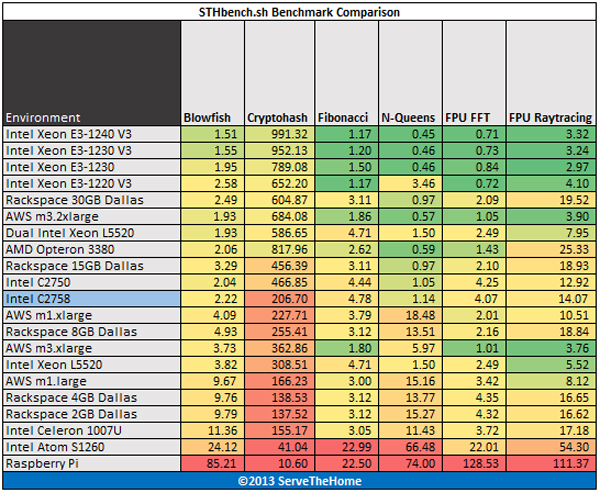
For the most part, the Intel Atom C2758 falls in-line with our expectations. The lack of Turbo Boost means that on single and multi-threaded benchmarks the chip will trail its Avoton C2750 counterpart. One area that we are still troubleshooting is the cryptohash benchmark. One would expect the Rangeley part to be either slightly slower of even faster but it seems to be significantly slower on the benchmark. We are still troubleshooting as to why but the results are easy to reproduce. We see the typical pattern of “Okay” single threaded performance with impressive 8-core multi-threaded performance here.
UnixBench 5.1.3 Performance
UnixBench may be a defacto standard for Linux benchmarking these days. There are two main versions, one that tests single CPU performance on that tests multiple CPU performance. UnixBench segments these results. We run both sets of CPU tests. Here are the single threaded results:
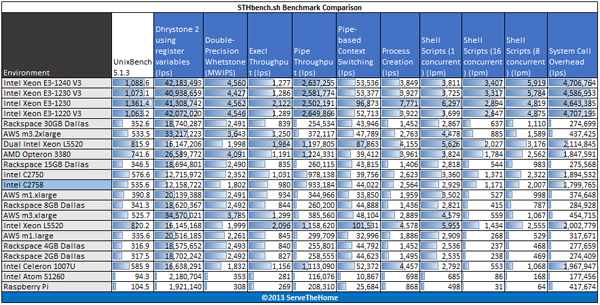
In terms of single threaded performance we can see the lack of Turbo Boost hold Rangeley back slightly. The C2758 aggregate score is within single digit percentage points of the Intel Atom C2750.
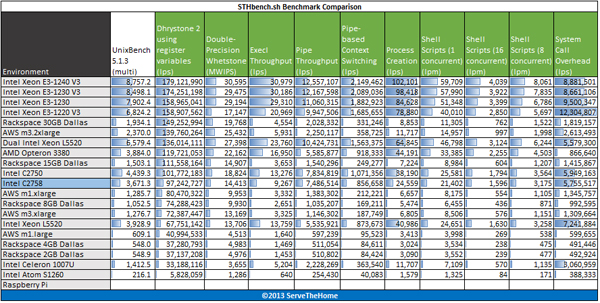
Moving to the multi-threaded results, we can see that the Intel Atom C2750 does hold an appreciable lead in multi-threaded performance. We generally use the multi-threaded Dhrystone 2 test to sort processors on and one can see that the Intel Atom C2758 actually has higher results than the Amazon AWS EC2 m1.xlarge and m3.xlarge instances as well as the Rackspace 8GB standard instance.
c-ray 1.1 Performance
c-ray is a very interesting ray tracing benchmark. It provides both consistent results and some clear separation. Ray tracing is generally a great multi-threaded CPU benchmark. For this test we use both a simple 7500×3500 render and a more complex 1920×1200 render. Here are the results:

The c-ray results are clear, solid Rangeley performance but slightly slower than Avoton.
Crafty Chess Performance
Crafty is a well known chess benchmark. It is also one where we saw issues last time with the Phoronix Test Suite and running on ARM CPUs. Here are the Crafty Chess results from simply running “crafty bench”:
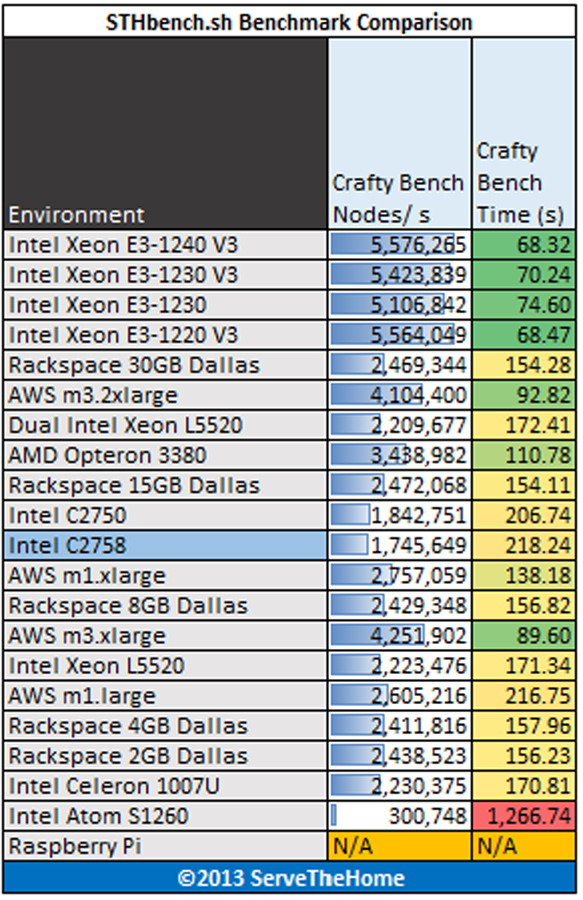
One can again see the performance falling slightly behind the Avoton based Intel Atom C2750. At the end of the day, these are very close in terms of performance. The current crafty benchmark we are using is single-threaded so Avoton/ Rangeley fall behind.
Phoronix Test Suite Performance
We are using four tests from the Phoronix Test Suite: pts/stream, pts/compress-7zip, pts/openssl and pts/pybench.
- STREAM by John D. McCalpin, Ph.D. is a very well known memory benchmark benchmark.
- 7-zip compression benchmarks were a mainstay in our Windows suite so we are including it again on the Linux side as a compression benchmark.
- The pts/openssl benchmark is very dependent on the CPU architecture being used
- Python is a widely used scripting language and pyBench is a nice single-threaded Python benchmark.
Here are the results of the Phoronix Test Suite benchmarks:

In terms of our four pts benchmarks, we see a familiar pattern, the Rangeley chip is a bit slower than its Avoton counterpart. The one major area of improvement here is that the pts/stream benchmark looks to be in-line with our expectation with the C2758 correcting what we saw as lower bandwidth on the C2750 platform.
Conclusion
Overall, performance of the Rangeley platform is in-line with what one may suspect. Turbo Boost on the Intel Avoton C2750 does help in a number of situations, especially the single threaded workloads. Bottom line is that for web server applications, the C2750 Avoton is probably a better choice. On the other hand, for those who are using or developing QuickAssist applications Rangeley may make sense. One other note is on pricing. The tray pricing for an Intel Atom C2758 is currently $208 while the C2750 is $171. Intel is charging a lot for these Atom processors so overall platform pricing is much higher than previous generation Atom processors. That pricing trickles through the supply chain making end product prices higher. If Intel priced these Atoms in the $100-$125 range they would likely still make a hefty profit given the size of the chips, but also sell many more. As ARM competitors enter the market, we do hope to see more competitive pricing from Intel. Right now, Intel does not have much competition in this processor segment which is keeping prices higher. Still, for low power network applications, Rangeley has a lot to offer.

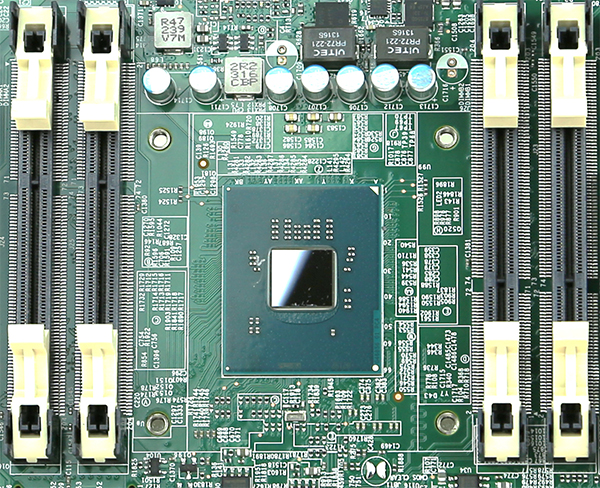



Do you know, if it supports VT-d or no?
Rangeley and Avoton do not. VT-x only.
What QuickAssist applications are currently available? Is it compatible with Intel Quick Sync?
Intel Website does not help much:
http://www.intel.com/content/www/us/en/io/quickassist-technology/quickassist-technology-developer.html
I have a Supermicro Rangley server up and running Sophos 9.2 Beta in bridge mode.
http://www.supermicro.com/products/system/1U/5018/SYS-5018A-FTN4.cfm
While installing the you only have one nic showing active. Just keep going with the install and when you link or bridge the nics the other nic came to life. Same thing from what I read happens with Untangle with i series nics.
Running great very very quiet. This replaces a D525 Atom Asus board/box with dual Itel server card. Helped out website page loads by quit a bit. I am very happy I bought and gambled with this server for running Sophos Home UTM.
Here is a picture of my rack build.
http://www.walleyecentral.com/forums/attachment.php?attachmentid=61338&d=1388078833
.
Added note. The .6 amp rating on the rack monitor was the D525 box in lower left of the picture running. I did not have ram yet for the Rangley. When I booted up the 8 core to my surprise, and horror, the meter now read 0.0. What good is a meter reading 0.0 .
Trying to figure out if the C2750 or C2758 would give me the best performance out of a Sophos UTM box running firewall, SPI, VPN, managed wifi, and virus scanning, and web filtering. Any one have any thoughts or suggestions?
Thanks. At least now I know that the board will run Sophos UTM. I was going to take a gamble and get one.
Wondering if the cryptohash anomoly in the hardinfo bench for the C2758 has anything to do with QuickAssist or a poor/incomplete implementation of it in the benchmark? I did a quick search to see if the benchmark had any support for QA but couldn’t find anything definitive.
Regarding the noise level you mention it’s very quiet.
Would that be max 25 dB?
I am looking at this SuperServer as well, and the model with four hard drives, but all I can get is that the fans do 56 dB max…
I know they have 4 pin PWM controlled by the IPMI, but Supermicro can’t tell me anything on idle noise levels.
Hi. Cryptohash was supposed to add support for QuickAssist this summer. Have you been able to repeat the bench for the C2758 to see how it does after the update?
So far someone is writing code from that the Intel QA will be profiting it
is a supported application, if there is no code that is using Intel QA it
will not benefit from Intel QA!
So the Rangeley platform is more interesting for peoples you are setting up
a firewall, UTM or another security device running the common tasks or
applications likes, AV scanning, IDS/IPS, DPI.
hi,
it would be nice to see another two tests based on the two main features and
where only the both Intel platforms will be compared against! Intel C2750 & C2758
and tests like VPN, IDS/IPS, DPI AV scanning and so on.
Using AES-NI on both sides
Using Intel QA on one side against without Intel QA.
Cheers frank